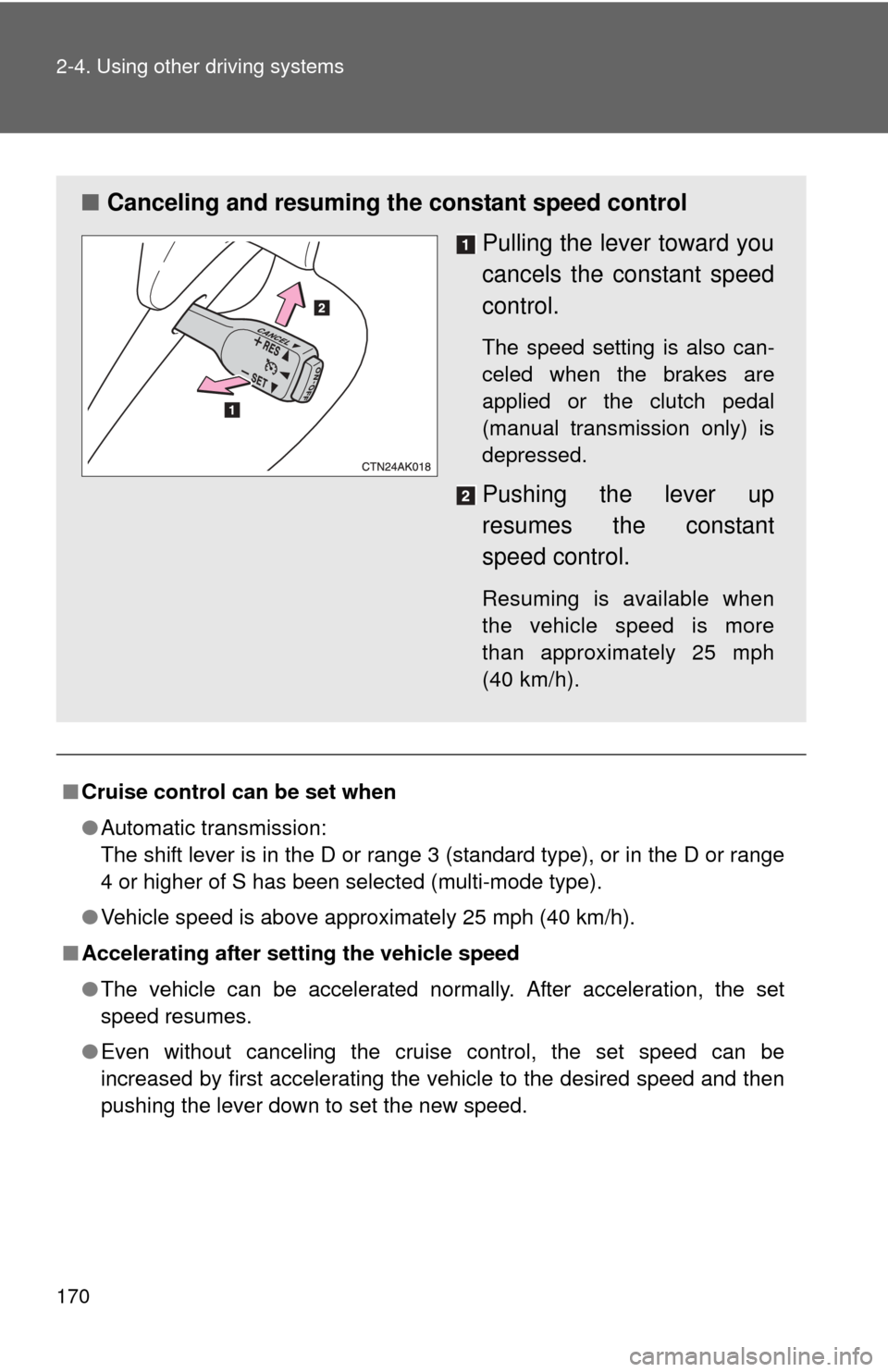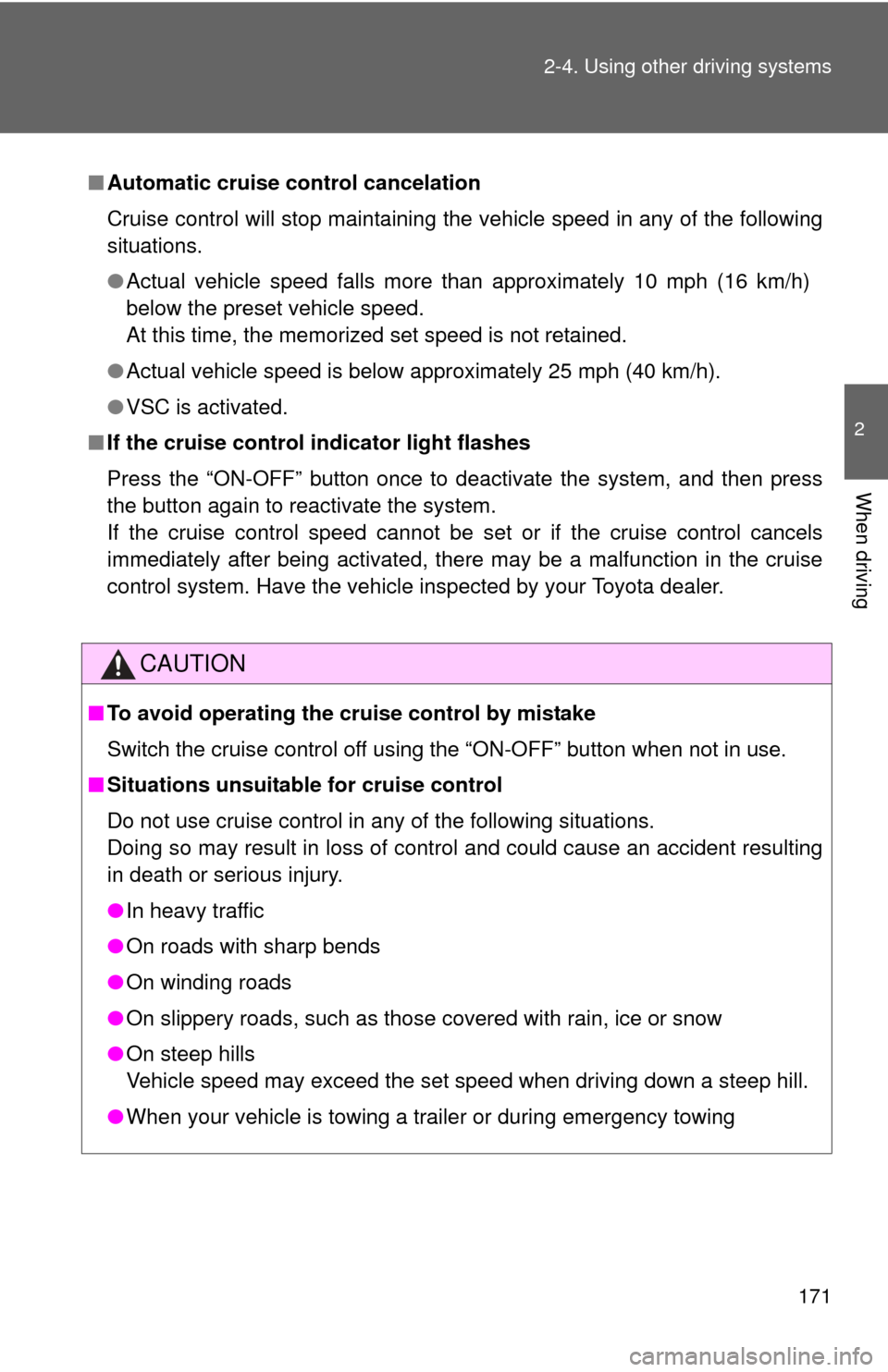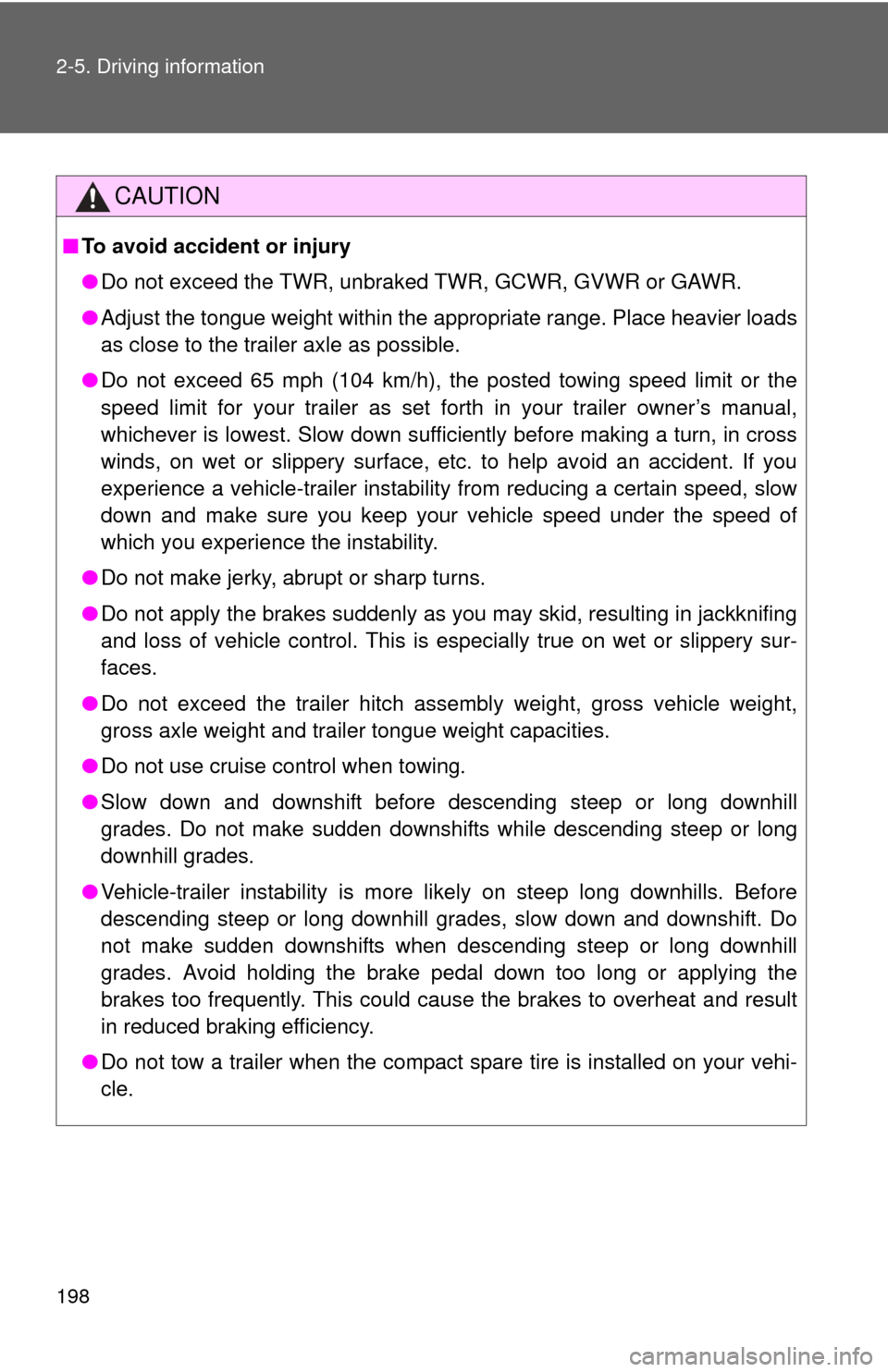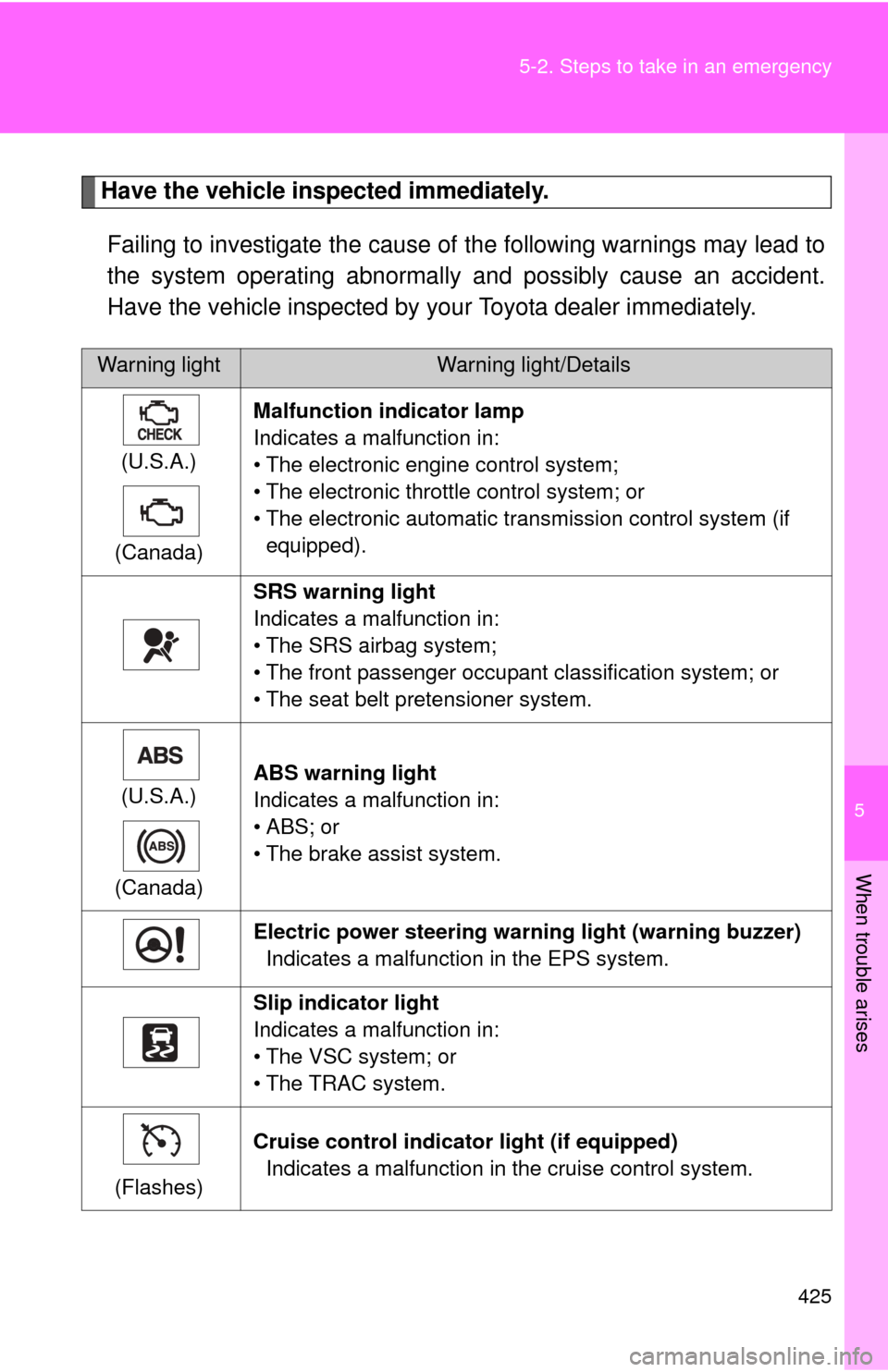Page 170 of 532

170 2-4. Using other driving systems
■Cruise control can be set when
●Automatic transmission:
The shift lever is in the D or range 3 (standard type), or in the D or range
4 or higher of S has been selected (multi-mode type).
● Vehicle speed is above approximately 25 mph (40 km/h).
■ Accelerating after setting the vehicle speed
●The vehicle can be accelerated normally. After acceleration, the set
speed resumes.
● Even without canceling the cruise control, the set speed can be
increased by first accelerating the vehicle to the desired speed and then
pushing the lever down to set the new speed.
■ Canceling and resuming the constant speed control
Pulling the lever toward you
cancels the constant speed
control.
The speed setting is also can-
celed when the brakes are
applied or the clutch pedal
(manual transmission only) is
depressed.
Pushing the lever up
resumes the constant
speed control.
Resuming is available when
the vehicle speed is more
than approximately 25 mph
(40 km/h).
Page 171 of 532

171
2-4. Using other
driving systems
2
When driving
■Automatic cruise control cancelation
Cruise control will stop maintaining the vehicle speed in any of the following
situations.
●Actual vehicle speed falls more than approximately 10 mph (16 km/h)
below the preset vehicle speed.
At this time, the memorized set speed is not retained.
● Actual vehicle speed is below approximately 25 mph (40 km/h).
● VSC is activated.
■ If the cruise control indicator light flashes
Press the “ON-OFF” button once to deactivate the system, and then press
the button again to reactivate the system.
If the cruise control speed cannot be set or if the cruise control cancels
immediately after being activated, there may be a malfunction in the cruise
control system. Have the vehicle inspected by your Toyota dealer.
CAUTION
■ To avoid operating the cruise control by mistake
Switch the cruise control off using the “ON-OFF” button when not in use.
■ Situations unsuitable for cruise control
Do not use cruise control in any of the following situations.
Doing so may result in loss of control and could cause an accident resulting
in death or serious injury.
●In heavy traffic
● On roads with sharp bends
● On winding roads
● On slippery roads, such as those covered with rain, ice or snow
● On steep hills
Vehicle speed may exceed the set speed when driving down a steep hill.
● When your vehicle is towing a trailer or during emergency towing
Page 198 of 532

198 2-5. Driving information
CAUTION
■To avoid accident or injury
●Do not exceed the TWR, unbraked TWR, GCWR, GVWR or GAWR.
● Adjust the tongue weight within the appropriate range. Place heavier loads
as close to the trailer axle as possible.
● Do not exceed 65 mph (104 km/h), the posted towing speed limit or the
speed limit for your trailer as set forth in your trailer owner’s manual,
whichever is lowest. Slow down sufficiently before making a turn, in cross
winds, on wet or slippery surface, etc. to help avoid an accident. If you
experience a vehicle-trailer instability from reducing a certain speed, slow
down and make sure you keep your vehicle speed under the speed of
which you experience the instability.
● Do not make jerky, abrupt or sharp turns.
● Do not apply the brakes suddenly as you may skid, resulting in jackknifing
and loss of vehicle control. This is especially true on wet or slippery sur-
faces.
● Do not exceed the trailer hitch assembly weight, gross vehicle weight,
gross axle weight and trailer tongue weight capacities.
● Do not use cruise control when towing.
● Slow down and downshift before descending steep or long downhill
grades. Do not make sudden downshifts while descending steep or long
downhill grades.
● Vehicle-trailer instability is more likely on steep long downhills. Before
descending steep or long downhill grades, slow down and downshift. Do
not make sudden downshifts when descending steep or long downhill
grades. Avoid holding the brake pedal down too long or applying the
brakes too frequently. This could cause the brakes to overheat and result
in reduced braking efficiency.
● Do not tow a trailer when the compact spare tire is installed on your vehi-
cle.
Page 400 of 532

400 4-3. Do-it-yourself maintenance
14 POWER30 A Power windows
15 SEAT HTR 15 A Seat heater
16 HTR-IG 10 A Air conditioning system
17 WIPER 25 A Windshield wipers
18 WASHER 15 A Windshield washer
19 ECU-IG NO. 1 10 A Automatic transmission, main body
ECU, electric power steering, elec-
tric cooling fan(s), shift lock control
system, anti-lock brake system, tire
pressure warning system, vehicle
stability control system, cruise con-
trol system
20 ECU-IG NO. 2 10 A Back-up lights, charging system,
rear window defogger, air condi-
tioning system, multiport fuel injec-
tion system/sequential multiport
fuel injection system, moon roof
21 OBD 7.5 A On-board diagnosis system
22 STOP 10 AStop lights, high mounted stop-
light, anti-lock brake system, main
body ECU, multiport fuel injection
system/sequential multiport fuel
injection system, shift lock control
system, vehicle stability control
system
23 DOOR 25 A Power door lock system
24 ACC-B 25 A CIG, ACC
25 FR FOG 15 A Front fog lights
26 AM1 7.5 A Starting system, ACC, CIG
FuseAmpereCircuit
Page 425 of 532

5
When trouble arises
425
5-2. Steps to take in an emergency
Have the vehicle inspected immediately.
Failing to investigate the cause of the following warnings may lead to
the system operating abnormally and possibly cause an accident.
Have the vehicle inspected by your Toyota dealer immediately.
Warning lightWarning light/Details
(U.S.A.)
(Canada) Malfunction indicator lamp
Indicates a malfunction in:
• The electronic engine control system;
• The electronic throttle control system; or
• The electronic automatic transmission control system (if
equipped).
SRS warning light
Indicates a malfunction in:
• The SRS airbag system;
• The front passenger occupant classification system; or
• The seat belt pretensioner system.
(U.S.A.)
(Canada) ABS warning light
Indicates a malfunction in:
•ABS; or
• The brake assist system.
Electric power steering warning light (warning buzzer)
Indicates a malfunction in the EPS system.
Slip indicator light
Indicates a malfunction in:
• The VSC system; or
• The TRAC system.
(Flashes) Cruise control indicator light (if equipped)
Indicates a malfunction in the cruise control system.
Page 521 of 532

521
Alphabetical index
Care
Exterior ................................. 336
Interior .................................. 338
Seat belts ............................. 339
Cargo capacity ........................ 176
CD changer .............................. 237
CD player ................................. 237
Chains ...................................... 181
Child restraint system
Booster seats, definition ....... 103
Booster seats, installation .... 107
Convertible seats, definition............................. 103
Convertible seats,
installation .......................... 107
Front passenger occupant classification system ............ 98
Infant seats, definition .......... 103
Infant seats, installation ........ 107
Installing CRS with LATCH anchors .............................. 108
Installing CRS with seat belts............................ 110
Installing CRS with top tether straps ....................... 114 Child safety
Airbag precautions ..................93
Battery precautions .......368, 459
Child restraint system............103
Child-protectors .......................42
How your child should wear
the seat belt ..........................62
Installing child restraints ........107
Moon roof precautions ............76
Power window lock switch.......71
Power window precautions .....72
Removed key battery
precautions .........................391
Seat belt comfort guide ...........59
Seat belt extender
precautions ...........................65
Seat belt precautions ..............64
Seat heater precautions ........327
Trunk precautions ...................49
Child-protectors .........................42
Cleaning
Exterior ..................................336
Interior ...................................338
Seat belts ..............................339
Clock .........................................323
Compass ...................................331
Condenser ................................364
Console box .............................313
Cooling system Engine overheating ...............461
Cruise control...........................168
Cup holder ................................315
Curtain shield airbags ...............86
Customizable features.............497C
Page 531 of 532
531
What to do if...
■
Warning lights
P. 426
or
P. 4 2 4P. 426
P. 4 2 4P. 425
P. 4 2 4P. 425
P. 425
or
P. 4 2 5P. 426
P. 4 2 5P. 426
P. 426
or
P. 4 2 5P. 426
P. 4 2 6P. 434
*: The light flashes to indicate a malfunction.
Brake system warning
lightTire pressure warning
light
Low windshield washer fluid level
warning light
Charging system warn-
ing lightElectric power steering
warning light
Low engine oil pressure
warning lightSlip indicator
light
Malfunction indicator
lampCruise control indicator
light
*
Open door warning light
SRS warning lightLow fuel level warning
light
ABS warning lightDriver’s seat belt
reminder light
Front passenger’s seat belt
reminder light
Maintenance required
reminder lightSmart key system warn-
ing light